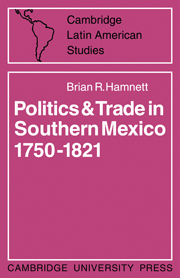Book contents
- Frontmatter
- Contents
- Acknowledgments
- Archival abbreviations
- Weights, measures, and currency
- Introduction
- 1 Oaxaca—environment and trade
- 2 The struggle for control of trade
- 3 The problem of reform, 1768–1786
- 4 Reform and reality—the crisis of the subdelegations in the 1790s
- 5 The Gálvez Plan under fire, 1786–1804
- 6 Finance, trade, and the merchants, 1789–1808
- 7 The political crisis of 1808–1821
- 8 Conclusion—Oaxaca within the context of Mexican politics
- Glossary of Personnel
- Appendices
- Sources and bibliography
- Maps
- Index
4 - Reform and reality—the crisis of the subdelegations in the 1790s
Published online by Cambridge University Press: 04 August 2010
- Frontmatter
- Contents
- Acknowledgments
- Archival abbreviations
- Weights, measures, and currency
- Introduction
- 1 Oaxaca—environment and trade
- 2 The struggle for control of trade
- 3 The problem of reform, 1768–1786
- 4 Reform and reality—the crisis of the subdelegations in the 1790s
- 5 The Gálvez Plan under fire, 1786–1804
- 6 Finance, trade, and the merchants, 1789–1808
- 7 The political crisis of 1808–1821
- 8 Conclusion—Oaxaca within the context of Mexican politics
- Glossary of Personnel
- Appendices
- Sources and bibliography
- Maps
- Index
Summary
After the climax period, 1769–78, the last years of the 1770s initiated the downward trend of cochineal prices which continued until 1796. The price decline was accompanied by the fall of production levels from the previous peak of between 1 million and 1 ½ million pounds to 464,625 pounds in 1781, and 537,750 pounds in 1785. These low levels were maintained—at between 430,000 and 600,000 pounds—between 1783 and 1796. They were accompanied by a price level between 15 and 17 reales per pound, or half the peak price level of 1771.
Production began to decline in 1781, with the drop to 464,625 pounds from a peak of 1,385,437½ pounds for the previous year. Such a sharp drop was the result of the reopening of war between Spain and Great Britain between 1779 and 1783. Bishop Bergoza of Oaxaca, writing in 1810, and looking back over the troubled history of the cochineal trade since the 1770s, attributed the decline to the British blockade of trade during those war years. For exports had been trapped in Oaxaca, or Veracruz, and even in Cádiz itself. The price of cochineal had slumped, with the result that the profitability of cultivating such a risky and delicate crop had declined. In consequence, the nopaleras had not been planted.
This interpretation was shared by the merchants of Oaxaca themselves, writing to Viceroy Azanza in December 1799.
- Type
- Chapter
- Information
- Politics and Trade in Mexico 1750–1821 , pp. 56 - 71Publisher: Cambridge University PressPrint publication year: 1971



